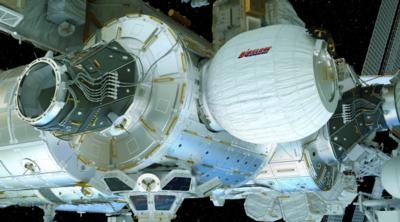Thu, Apr 14, 2016
BEAM Launched By SpaceX To The Station April 8
The first human-rated expandable structure that may help inform the design of deep space habitats is set to be installed to the International Space Station Saturday, April 16.

The Bigelow Expandable Activity Module (BEAM) will be attached to the station's Tranquility module over a period of about four hours. Controllers in mission control at NASA's Johnson Space Center in Houston will remove BEAM from the unpressurized trunk of SpaceX's Dragon spacecraft, using the robotic Canadarm2, and move it into position next to Tranquility's aft assembly port. NASA astronauts aboard the station will secure BEAM using common berthing mechanism controls. Robotic operations begin at 2:15 a.m. and are expected to be complete by 6:15 a.m.
BEAM launched aboard Dragon on April 8 from Cape Canaveral Air Force Station in Florida. At the end of May, the module will be expanded to nearly five times its compressed size of 7 feet in diameter by 8 feet in length to roughly 10 feet in diameter and 13 feet in length.
Astronauts will first enter the habitat about a week after expansion and, during a two-year test mission, will return to the module for a few hours several times a year to retrieve sensor data and assess conditions.
Expandable habitats are designed to take up less room on a rocket, but provide greater volume for living and working in space once expanded. This first test of an expandable module will allow investigators to gauge how well the habitat performs overall and, specifically, how well it protects against solar radiation, space debris and the temperature extremes of space. Once the test period is over, BEAM will be released from the space station, and will burn up during its descent through Earth's atmosphere.
BEAM is an example of NASA's increased commitment to partnering with industry to enable the growth of the commercial use of space. The BEAM project is co-sponsored by NASA's Advanced Exploration Systems Division and Bigelow Aerospace.
The International Space Station serves as the world's leading laboratory for conducting cutting-edge microgravity research and is the primary platform for technology development and testing in space to enable human and robotic exploration of destinations beyond low-Earth orbit, including asteroids and Mars.
(Image provided with NASA news release)
More News
Airplane Bounced About 3 Ft Then Touched Back Down And Then, With No Brakes Applied, The Airplane Began Veering To The Left Analysis: The pilot entered the airport traffic pattern >[...]
Aero Linx: British Microlight Aircraft Association (BMAA) The primary focus within all aviation activity is SAFETY. In all aspects of our sport SAFETY must come first, whether it b>[...]
From SnF25 (YouTube Edition): William Wynne Builds Practical Aircraft Engines on the Corvair Platform Seeking an affordable alternative to the traditional aircraft engine options, >[...]
How To Get A Story On Aero-TV News/Feature Programming How do I submit a story idea or lead to Aero-TV? If you would like to submit a story idea or lead, please contact Jim Campbel>[...]
From 2023 (YouTube Edition): Bridge of CiES CiES Inc. is a Bend, Oregon-based designer and manufacturer of modular embedded aircraft systems and sensors. The company’s fuel-l>[...]
 NTSB Final Report: Aviat A1
NTSB Final Report: Aviat A1 ANN's Daily Aero-Linx (07.08.25)
ANN's Daily Aero-Linx (07.08.25) Classic Aero-TV: Fly Corvairs Reliable Engine Alternative
Classic Aero-TV: Fly Corvairs Reliable Engine Alternative ANN FAQ: Contributing To Aero-TV
ANN FAQ: Contributing To Aero-TV Classic Aero-TV: CiES Fuel-Quantity and e-Throttle Systems Praised
Classic Aero-TV: CiES Fuel-Quantity and e-Throttle Systems Praised



